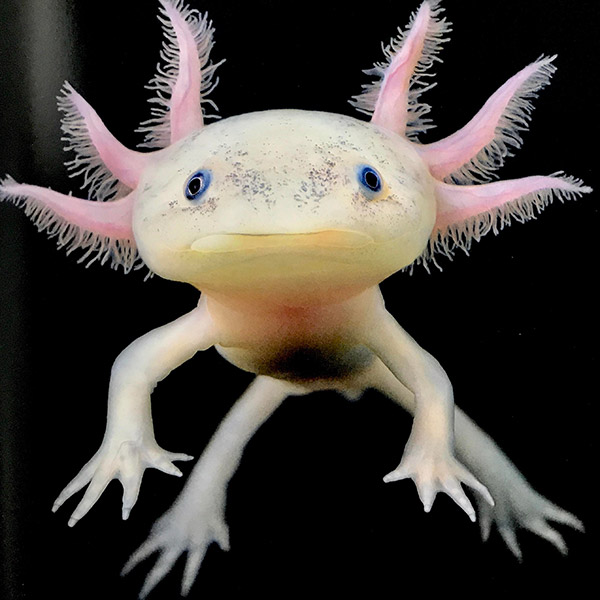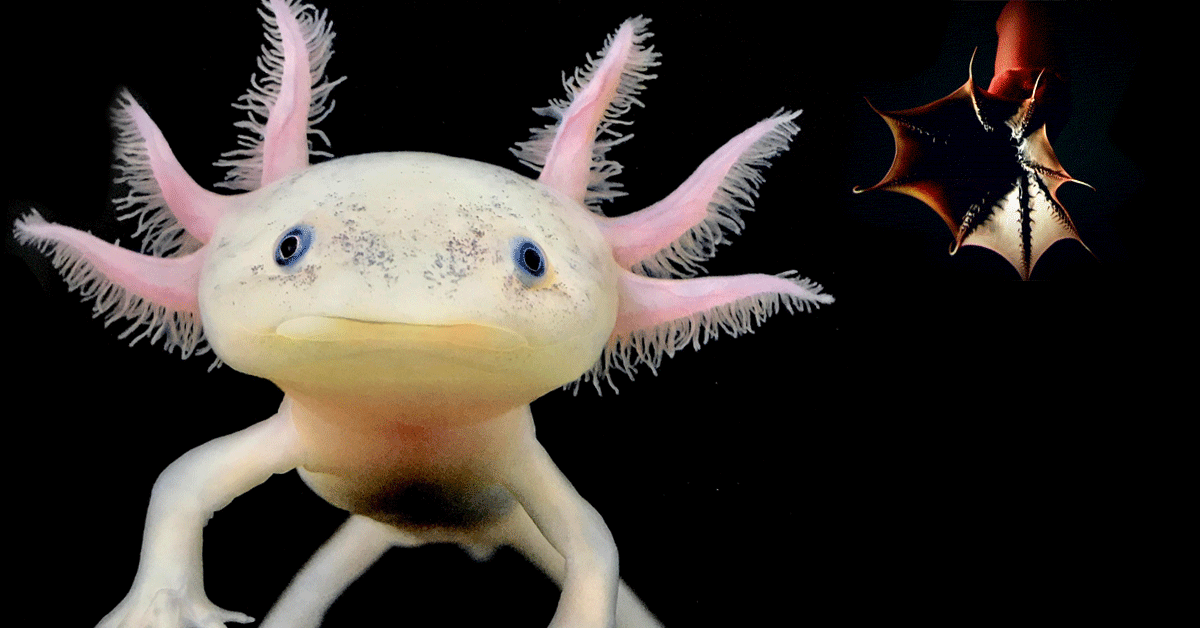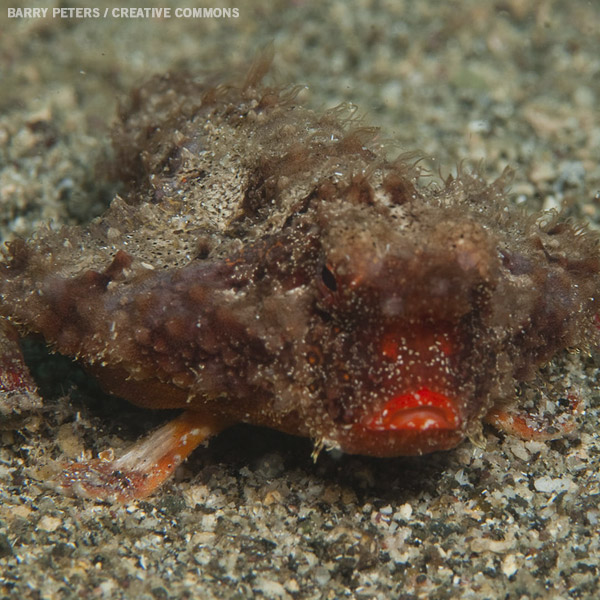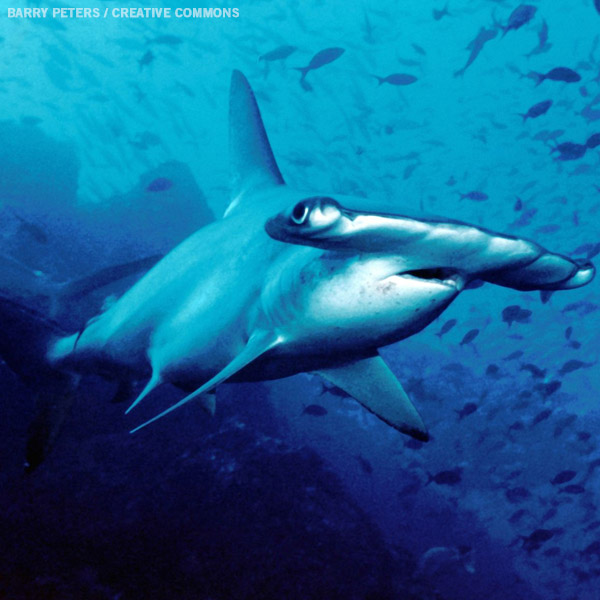
Forget polar bears & baby seals: 12 quirky creatures yule love (or should) this Christmas

At Christmastime we’re surrounded by images of cute and cuddly creatures great and small – from fuzzy baby polar bears and doe-eyed seals, to waddling penguins. But what about those scaly or slimy animals not fortunate enough to conform to our conventional standards of adorableness? Or their behaviour makes them a little different?
Our rivers, oceans and lakes are full of such quirky creatures and, even though they might not be the prettiest to look at, they still need our love and care – particularly in the face of plastic pollution and the climate crisis. After all, their survival matters just as much as that of their fluffier, more relatable counterparts, but they often don’t make the headlines.
Take action on plastic pollution all year long, become a member of Surfers Against Sewage today.
So, to show just how much of a tragedy the loss of any one of them would be, we’ve put together a selection of these largely overlooked critters, from the ‘world’s ugliest animal’, to the freaky disco comb jelly, the vampire squid and beyond. They each have something unique and cool about them. Some of them could even teach us a fair bit about how to live ourselves- despite not being at the top of anyone’s cutest creature list.
 We only ask one thing: if you find yourself feeling even a little moved by any of them, why not sign up to a year’s membership to Surfers Against Sewage? By protecting our coastlines and stopping plastic pollution at source by challenging businesses and the government we can stop plastic flooding into oceans and badly harming our sea life – from the cute and cuddly to the weird and wonderful.
We only ask one thing: if you find yourself feeling even a little moved by any of them, why not sign up to a year’s membership to Surfers Against Sewage? By protecting our coastlines and stopping plastic pollution at source by challenging businesses and the government we can stop plastic flooding into oceans and badly harming our sea life – from the cute and cuddly to the weird and wonderful.
The blobfish – who are you calling ugly?
The blobfish won’t be winning any awards for cutest-in-show anytime soon. In fact, it did win an award in 2013…for world’s ugliest animal. But despite its obvious aesthetic shortcomings, the blobfish has lot else going for it.
Unlike most other fish, it lacks a swim-bladder, as well any significant muscular structure to speak of. What this means is that swimming is impossible- but our less-than-pretty friend has little need of activities as inefficient as swimming. Instead, it uses deep sea currents to propel itself slowly along the seafloor whilst it hoovers up its prey. And here, the blobfish isn’t fussy. Almost anything dead and nearby will do: crabs, sea urchins, whatever happens to float into its mouth. If it were a consumer, it would have an almost non-existent carbon foot (or blob) print.
In short, it’s a model of efficiency and adaptability, and many of us could do with adopting a similar approach to how we live – after all, it’s largely thanks to our wasteful and destructive practices that only ~400 of these wonderful, but admittedly rather weird, creatures are estimated to still exist.
The deep-sea angler fish – awesome allure
Whilst the blobfish may look a little odd this, its deep-sea neighbour, seems downright stand-offish. This is largely due to its immediately recognisable and unique method of predation. Yep. This is the fish with the bioluminescent lure that dangles a foot or so above its large and extremely intimidating mouth. But, once you get past their terrifying appearance, there’s much to admire about this alien from the deep.
What’s perhaps most extraordinary about them- apart from their luminous lure, or esca-, are their reproductive practices. The male, who is around four times smaller than the female, essentially acts as a parasite once attached to his mate by its teeth. She can carry up to six of these small fellows at a time- but only one will manage to actually mate: a process which involves the merging of all organs and physiological systems until all that remains of the male are its testes. Perhaps this doesn’t make the deep-sea anglerfish any less fearsome, but it certainly qualifies them as one of the more fascinating creatures in our oceans.
The ocean sunfish – gentle giants
The ocean sunfish (or mola) looks as though it was put together in a hurry, perhaps out of spare parts. Or maybe by Picasso in one of his more experimental cubist phases. The sheer bulk of these creatures can also make them seem intimidating: the largest have been known to reach 14 feet and 5,000 pounds.
Despite their less than cute appearance however, they’re gentle giants- unless you happen to be a jellyfish or species of plankton. They spend the majority of their time just below the water’s surface, basking in sunlight. When they’re not sunbathing, you can find them trying to rid themselves of their various parasites, a process that entails inviting multiple smaller fish to feed on the unwanted guests camped out on the surface of their skin. These aquatic philanthropists play a vital role in sustaining their ecological community– which is more than can often be said for us humans.
Vampire squid – not a vampire or a squid
Admittedly, the name doesn’t do it any favours. The fact that it spends all of its time lurking in total darkness in the deepest parts of our oceans wearing what could best be described as a red cloak of skin over its eight extendable limbs – hence the name- also doesn’t help.
But appearances- and names- can be deceiving. It’s neither a squid nor a vampire. It’s an evolutionary relic, the only surviving member of its cephalopod group. And instead of preying on helpless victims, this ancient curio spends its time hoovering up the ocean’s detritus: a detritivore- literally meaning garbage eater- it feeds on the corpses and faeces of long dead animals. So, like many of its deep-sea neighbours, it puts our own often wasteful practices of consumption to shame. And this seems to be working: it’s been around since before the dinosaurs.
Christmas tree worms – not your average worm
Worms of any kind probably aren’t at the top of anyone’s list of cutest animals. But these, just like their dry-land equivalents, play an absolutely vital role in maintaining the balance of their native habitats. Each worm consists of a single tube-like structure, made of calcium carbonate, and two protruding Christmas-tree-like crowns, or radioles.
The worm uses these crowns to filter an array of micro-organisms from the water and deliver them to their digestive tract- essential for both their own health and that of the surrounding environment. And whilst they’re not exactly cute, at least not in the conventional, cuddly way, they are quite spectacular looking creatures. They come in an array of dazzlingly bright colours, from orange to yellow, to blue and white, and they form some incredibly intricate spirally patterns – maybe don’t mention this to our relatively plain earthworm.
Axolotl – the Peter Pan of amphibians

Ok: so the axolotl is admittedly quite cute. But in many ways this is part of the problem. This wonderful little amphibian is highly endangered, and this is due in large part to its increasing popularity as a novelty pet- not to mention the introduction of larger, non-native fish into its native habitat and increasing levels of pollution.
Now, the loss of any species is a tragedy- but there’s so much that’s unique and precious about the axolotl- all cuteness aside- that it seems particularly awful to think that this little guy might disappear forever. Take for instance its highly unusual appearance, due to a rare condition called neoteny. Possessing this peculiar genetic trait means that the axolotl retains many of its features from the larval stage of development. It’s the Peter Pan of amphibians! Add to this its incredible regenerative abilities and the capacity to detect electrical currents, and you’ve got something like an underwater super hero.
Sarcastic fringehead – don’t make it angry
The sarcastic fringehead almost makes the deep-sea anglerfish look friendly. It lurks in tube-like holes left by clams and other crustaceans – it’s even been known to creep into plastic bottles. But at rest it’s only mildly scary: things get really weird once it feels threatened. At the slightest provocation, the fringehead’s mouth will fly open to four times its closed width, revealing a fluorescent inner lining and two rows of needle-like teeth that our snappy friend here loves nothing more than sinking into its unfortunate victims. And once attached, it’s notoriously hard to shake free. Comparisons have been made to terrifying movie monsters from ‘Alien’ and ‘The Predator’.
Despite this however, the fringehead has some remarkably progressive ideas about gender roles, it seems. After giving birth, the female deposits her eggs in the lair of the male, who cares for them dutifully until maturity. So really, they’re sweeties… sort of. Also, whilst you might not want one anywhere near your immediate vicinity, you have to admit: they are a pretty bad-ass fish to behold- especially when the males engage in mouth-to-mouth combat.
Dumbo octopus – the 9th wonder of the ocean
Like the axolotl, this little creature is actually quite easy on the eye. In fact, it’s so cute that the first researchers to study it decided to name it Opisthoteuthis adorabilis. But we’ve decided to include it here to show that not all inhabitants of the oceans deeps are, well, frankly a little creepy.
Plus, living at such great depths – up to 18,000 feet, making them the deepest-living known octopus – they aren’t likely to be on anyone’s Christmas card list. But they should be. Far more than a pretty face, these little creatures are unusual for their method of swimming: instead of jet-propulsion,they use the small fins on either side of their heads- or mantle- to propel themselves along, ala Dumbo. They are also really small; tiny, in fact- a mere eight inches in height. Add to this their unusual bell-shaped body and you have a truly remarkable little octopus.
Tardigrades (‘water bears’) – Earth’s toughest animal?
These micro-animals get their name from the striking proportional resemblance of their bodies to that of bears. And, admittedly, at first glance they seem pretty cute and cuddly, with their relatively large, puffy abdomens and tiny heads.
But wait until they spot some food- tardigrades have telescopic mouths with rows of sharp, dagger like teeth that they like to insert into whatever seems tasty nearby. And when you take a really close look at them under the microscope, it makes you mighty glad you’re the size you are.
But looks aside, these really are quite incredible little creatures. Once in their dormant state, curled up into what scientists call ‘tuns’, they can survive for centuries at radically decreased levels of metabolic activity. And not just in our oceans- almost anywhere, it seems. They’re so hardy, in fact, that researchers decided to launch some into space to see if they’d survive: they did-and they even managed to breed. Incredible.
Red-lipped batfish – where’s the mistletoe?
It’s hard to know where to begin with the red-lipped batfish. There are the oversized, bright red lips; the strange part fin/ part leg-like appendages it uses to wobble along the ocean floor; the lure that extends from the centre of its forehead. It looks partly like a fish, partly like an extra from the ‘Rocky Horror Picture Show’. But all jokes aside, all of these quirks make the batfish a highly efficient predator.
Being so close to the ground and moving so slowly actually provides a massive advantage to a bottom-feeder like our friend here. The lure helps too. And as for the lips… well no-one actually knows what they’re for. But who are we to judge? They can have bright red lips if they want to- if nothing else, they sure make a fish look sassy.
Scalloped hammerhead – Stop, hammer time!
So-called for the scalloped edge to their wide, flat heads, these sharks reach on average 2.5-3 meters in length and 152 kilograms in weight. So they’re big. And, you know, scary – they’re sharks. Their wide head actually goes a long way towards making them the incredible predators they are – having all of their sensory organs spread out is what gives them their extraordinary perceptive capacities.
But despite their fearsome appearance and brutal efficiency, the scalloped hammerhead actually poses almost no threat to humans. It has a relatively small mouth, so rarely preys on anything larger than a stingray, and they’re actually incredibly shy. In fact, we’re far more of a threat to them than they are to us: their sort-after fins have made them a prime target for fishers. And its strange tendency to gather in huge groups at yearly intervals makes them easy to pick off in large numbers -as a result, this admittedly intimidating, but really quite incredible creature, is now endangered.
Comb jellies – deep blue disco divas
Who cares about being cute when you can be this fabulous? To do this bizarre, yet strikingly beautiful, animal full justice you’d probably need to play Donna Summer’s 1977 disco classic ‘I Feel Love’ in another tab. They’re pretty groovy creatures.
And their remarkable appearance is a result of their just-as-remarkable method of locomotion: the eight strips of tiny hairs (or cilia) they use to propel themselves through the water have a tendency to scatter light as they move, creating a kind of rainbow barber-shop-pole effect that travels their length. Add to this the bioluminescent blue of their bodies, and their tendency to squirt glowing ink when threatened, and you’ve got yourself a seriously happening invertebrate. Just… wow.
Blog by Alex Lopez
Drastic measures are needed to protect the marine environment. Become a member today to help us tackle pollution in our seas and on the beaches, inspire communities to take action and push for change at the highest level.
